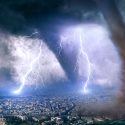Have you ever felt like it was so hot out that you could cook an egg on the road? Or do you enjoy incredibly spicy foods for the thrill of it? Well, imagine living in an area that’s hot as fire, around 1,000 °C.
Could anything survive, or would we all be barbecued? It’s time to fire up the grill as things are gonna get toasty. What would happen if the atmosphere was as hot as lava? Would our air catch fire if it was heated to 1,000 °C? And could life survive this extreme heat if it lasted only five seconds?
Throughout history, Earth has experienced some pretty extreme heat, ranging from 204 °C (400 °F) to 2027 °C (3,680 °F). Mind you, these temperatures occurred billions of years ago during Earth’s cooling process.
But certain events provided temporary heat pulses hot enough to almost wipe out all life on Earth. The asteroid impact that demolished the dinosaurs managed to bump up the global temperature by 5 °C (41 °F) for 100,000 years. This impact was equivalent to more than one billion Hiroshima bombs. And yet, life still managed to survive. So, how did anything manage to live through this?
Well, life survived that devastating asteroid because it was a localized event. Areas close to the impact experienced an intense but short-lived heat blast that lasted about 1.5 minutes. It was so hot that parts of Earth’s atmosphere began to boil. That’s around 20 times hotter than any human could tolerate.
However, simulation research suggests that this heat wasn’t evenly distributed across the surface of the Earth. Areas further from the impact experienced a less intense heatwave that lasted up to 7.5 minutes.
What’s most peculiar is that researchers discovered that the areas closest to the impact didn’t catch fire. Rather, it was the areas further away from the blast that went up in flames. While these areas weren’t as hot as the impact site, the heat lasted long enough for plants to ignite, causing devastating wildfires.
Okay, but what would happen if we cranked up the heat throughout the atmosphere? Would just five seconds of heat be enough to wipe us out? Well, it’s not the five seconds we need to be worried about. It’s what happens after.
The first thing to catch fire would be our trees, igniting wildfires on a global scale. If you live in a log cabin, well, you might want to relocate. The spread of wildfires worldwide could prevent animals from moving to safety unless they were deep underwater.
Any humans outside would experience second-degree burns. Inhaling the air would be lethal and would destroy your respiratory tract. People who inhale smoke from fires have a greater risk of death than burn victims due to severe lung injuries.
We would all have to hunker down in a refrigerated bunker somewhere to survive. Realistically, it would take weeks or even months for the wildfires to go out. Like an asteroid impact, the overall global temperature would increase several degrees, lasting for hundreds of thousands of years.
We would be facing even more extreme global warming effects, like dangerous weather, mass extinctions, and food shortages worldwide. The most damaging effects would be seen in Earth’s lowest atmospheric layer, the troposphere, where the highest density of gas is.
While you might think the air would catch fire at 1,000 °C, our atmosphere is made up of more than flammable oxygen. 78% of it is the inert gas, nitrogen. Inert gases have extremely low reactivity and don’t catch fire as quickly as oxygen. So, what about higher up, in the thermosphere, where the nitrogen levels are lower?
Well, at such high altitudes, the oxygen density is so extremely low that gas particles don’t collide as often as they do closer to the surface. While Earth doesn’t experience such extreme temperatures in its atmosphere these days, other exoplanets, like WASP-189b, reach surface temperatures of 3,200 °C (5,800 °F). This happens because it orbits its massive star so closely that it absorbs most of its solar radiation.
Sources
- “Dinosaur-Killing Impact May Have Superheated Earth’s Atmosphere For 100,000 Years – Extremetech“. Hruska, Joel. 2018. Extremetech.
- “Earth’s Atmosphere: Composition, Climate & Weather”. Tim, Sharp. 2021. space.com.
- “Scientists Have Found A New Exoplanet With An Atmosphere So Hot It Could Melt Iron”. 2020. News18.
- “Revealed: asteroid that killed the dinosaurs boiled Earth’s atmosphere”. 2015. The Conversation.
- “How Hot Does A Campfire Get? Every Camper Needs To Know This”. John, Brian. 2017. Enjoy The Wild – Outdoor Activities/ Adventure/ Survival/ Travel.
- “What Is The Melting Point Of Iron?“. reference.com.
- “Climate And Earth’S Energy Budget”. 2021. earthobservatory.nasa.gov.



























